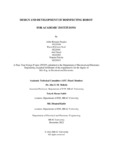Design and development of disinfecting robot for academic institutions
Abstract
Cleaning up areas where people assemble is necessary due to the proliferation of several fatal
infections, including the coronavirus. Nowadays, humans perform disinfection procedures in a
variety of settings, which doesn't result in efficient results and may even be harmful to people.
The COVID-19 pandemic has resulted in widespread school closures and an enormous crisis
in education. While the past almost two and a half years have been difficult for all of us,
students were especially impacted by the extended closure of their schools. In light of this, a
technological solution to the issue has been developed to disinfect classrooms using an IoT based UV-C disinfection system. Although the sterilizing properties of the C-band of
ultraviolet (UV) radiation are universally acknowledged, their application has recently become
more important and common due to the Covid-19 outbreak. Usually utilized in a regulated
manner, UV light produces no waste and is environmentally beneficial. Six UV-C lights that
cover the entire system's 360 degrees are linked to the top of the structure in this project. It is
a semi-autonomous device that will be operated by a mobile application and will follow the
necessary safety protocols to shield students from UV ray exposure. The system will have a
limited range for objects and human detection. Moreover, the device will immediately turn off
when humans are detected within a 36-meter range. The method is also capable of identifying
those who exhibit early symptoms of viral assaults. According to the findings, this device
requires 10-15 minutes of UV-LED exposure for any microbe to fully perform its germicidal
functions.

